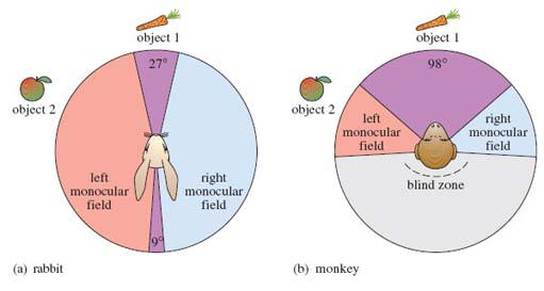We first need to differentiate between monocular and binocular cues. Animals that have two eyes on opposite sides of their head (e.g., some fish) have to analyze sensory information coming in from a single perspective, and therefore rely solely on monocular (one-eyed) cues. Other animals have two eyes that face forward towards the front of their heads, and therefore can use both monocular and binocular (two-eyed) cues... depending on where the light is coming from. As the image below illustrates, where the eyes are placed determines which areas can be analyzed with which cues.
 |
| http://bit.ly/2aQ8d3D |
Monocular cues are taken from a single perspective (eye). Close one eye and look around the room… everything doesn’t go flat. Some things are still clearly closer to you than others, and you could still walk to the other side of the room without bumping into things or hitting the wall.
You will to describe how brains analyze visual information from one eye and perceive depth using:
- Interposition http://psych.hanover.edu/krantz/art/inter.html
- Relative height http://psych.hanover.edu/krantz/art/rel_hgt.html
- Familiar/Relative size http://psych.hanover.edu/krantz/art/rel_size.html
- Texture gradient http://psych.hanover.edu/krantz/art/texture.html
- Shadow http://psych.hanover.edu/krantz/art/shadow.html
- Linear perspective http://psych.hanover.edu/krantz/art/linear.html
- Motion parallax: http://psych.hanover.edu/krantz/motionparallax/motionparallax.html and http://www.youtube.com/watch?v=3HMkoNYlEfs
- Accommodation: For accommodation, the following video describes how the muscles adjust the lens in order to focus. Note that the state of the ciliary muscles, and therefore the the shape the lens, would tell our brain how close or far something is once we focus on it. https://www.youtube.com/watch?v=YtpRpttPnHw
To see how some of these cues can be used to create the illusion of depth, take a look at the sidewalk art of Julian Beever. As you watch this video, pick an image that you particularly like and be prepared to discuss how all of the monocular cues are used to fool our brain into perceiving depth.
Watch: Julian Beever Chalk Drawings (http://youtu.be/wbYgmGzVooI)
Watch: Julian Beever Chalk Drawings (http://youtu.be/wbYgmGzVooI)
Not all animals have two eyes that converge on the same thing. However, those that do can also use binocular cues to perceive depth and motion. We will focus on binocular (a.k.a. retinal) disparity:
Read: Binocular Vision - Retinal Disparity (http://goo.gl/H4qIjl)
Watch this video on how 3D movies work and virtual reality headsets, which really helps explain binocular disparity. Of course, back in the day, we used red and blue glasses to trick the brain into seeing a different image in each eye… 3D has come a long way.
Watch: James Cameron Stereoscopic 3D Camera (http://youtu.be/tlc_7SjSfUg)
Read: Binocular Vision - Retinal Disparity (http://goo.gl/H4qIjl)
Watch this video on how 3D movies work and virtual reality headsets, which really helps explain binocular disparity. Of course, back in the day, we used red and blue glasses to trick the brain into seeing a different image in each eye… 3D has come a long way.
Watch: James Cameron Stereoscopic 3D Camera (http://youtu.be/tlc_7SjSfUg)
OPTIONAL: See how the same depth perception trick is used to make virtual reality headsets using your phone and some cardboard.
